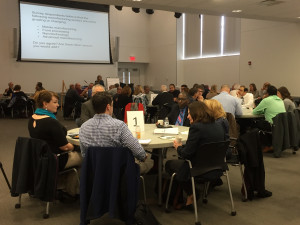A brighter future begins with a plan

Dozens of employers gather at SUNY Poly in February 2017 to develop a plan to create a bright future of manufacturing in the area Along with funding support from the New York State Department of Labor, the Mohawk Valley Advanced Manufacturing Project was born, with one goal in mind – to align all the training and educational resources available in the region with the needs of the area’s employers.
While there are many that lament the days of manufacturing as it once appeared across the United States, many remain optimistic that manufacturing has not disappeared, it has just changed and evolved with growing times and technology.
It is with that outlook for a bright days ahead that brought Alice Savino, the Executive Director of the Workforce Development Board of Herkimer, Madison, and Otsego Counties to approach Kathleen Alcott, Associate Director of Northeast Advanced Technological Education Center (NEAC) housed at SUNY Poly on a way to make that future a reality.
The first step was bringing together dozens of employers from across the region to the SUNY Poly Student Center in Utica on February 28 to work together and develop a plan to see that envisioned future through.
Along with funding support from the New York State Department of Labor, the Mohawk Valley Advanced Manufacturing Project was born, with one goal in mind – to align all the training and educational resources available in the region with the needs of the area’s employers.
“The manufacturing sector continually evolves with new products, new technologies, and new needs,” Savino said. “As times change, we want to anticipate changes to be ready with training when manufacturers need workers.”
Despite the products they make or how they are made, employers from across the region were invited to attend the planning session at SUNY Poly and help inform each other, and the Workforce Development Board of what they need. This, it is hoped, will help the Board as it seeks funding to grow the region’s manufacturing sector with a focus on the top priorities and needs of the employers.
The kickoff event at begins an effort across sectors in an effort to develop a workforce education and training strategy to cover the entire region as well as target both urban and rural populations. Following the kickoff meeting, the WDB, SUNY Poly, and regional employers will develop a manufacturing sector development plan that will be used by the WDB, along with the New York State Department of Labor and the Mohawk Valley Regional Economic Development Council, to provide resources that are needed to put the developed strategies into action.
“Sometimes education is slow to react to changes in the business world,” says Alcott. “It’s easy for schools and manufacturers to stay in our respective silos and keep doing what we’re doing, but if we truly want to prepare a skilled workforce to work with today’s high tech equipment, we have to have these conversations, on a regular basis! The baby boomers that are working in manufacturing jobs are retiring. There will be lots of good paying jobs to fill throughout our region. Automation breaks down; manufacturers will always need people to work with the machines. There are plenty of other jobs too within a manufacturing enterprise that will need to be filled such as sales and marketing, HR, billing, quality control, information technology, supply chain management, etc.”
The final strategy will be presented to the state in June as the region’s Manufacturing Development Plan.
Savino says that the effort and strategies hope to accomplish a myriad of goals along the way, that include uniting partners across the region to better serve manufacturers; help employers with increasing productivity and customer satisfaction, training workers, and decreasing turnover; develop a regional training plan to upgrade the skills of existing employees; create a training pathway for entry-level employees and develop a deep pool of potential employees to help employers expand; and connect populations that need re-training with the programs that can place them in good-paying jobs.
“I’m very hopeful. There’s no doubt that future manufacturing will look different in our region. Firms will be smaller and more automated. It’s not going to look like our grandfathers’ manufacturing job, but it will provide our area’s workforce with clean, safe, good paying jobs – and that is good news!” says Alcott. “They had the opportunity to listen to each other. What do manufacturers need, what can schools and workforce development agencies provide and where are the gaps? I saw lots of networking happening after the event with manufacturers talking to apprenticeship program coordinators, veteran outreach programs, and community college professors. I saw lots of business cards shared so to me, that’s a success!”
Recent Comments
Archives
- September 2018
- August 2018
- May 2018
- April 2018
- March 2018
- February 2018
- January 2018
- December 2017
- November 2017
- October 2017
- September 2017
- May 2017
- April 2017
- March 2017
- February 2017
- January 2017
- December 2016
- November 2016
- October 2016
- September 2016
- August 2016
- May 2016
- April 2016
- March 2016
- February 2016
- January 2016
- December 2015
- November 2015
- October 2015
- September 2015
- August 2015
- May 2015
- April 2015
- March 2015
- February 2015
- January 2015
- December 2014
- November 2014
- October 2014
- September 2014
- August 2014
- May 2014
- April 2014
- March 2014
- February 2014
- January 2014
- December 2013
- November 2013
- October 2013
- September 2013
- August 2013
- June 2013
- May 2013
- April 2013
- March 2013
- February 2013
- January 2013
- December 2012
- November 2012
